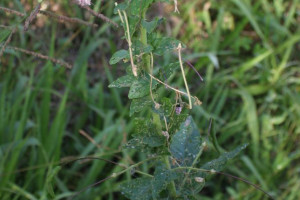Descripcion
Hierbas o arbustos de 0,7 a 1,8 m de alto; ramas pubescentes a glandulares-pilosas en todas partes. Hojas con pecíolos de 3,5-9 cm de largo, pubescentes, generalmente armados con espinas rectas, delgadas o gruesas; espinas estipulares, de 3-4 × 2 mm, rectas; pecíolulos de 1-3 mm de largo, inermes, densamente pubescentes; láminas 5-7 folioladas, folíolos elípticos a oblanceolados, de 3,8-8,5(-12) × 1,5-2,5(-4) cm, basalmente cuneados a atenuados, apicalmente agudos a acuminados, margen minuciosamente serrulado-ciliado, ambas caras pubescentes, nervadura central y venas secundarias pubescentes, con espinas. Inflorescencia en racimos corimbiformes, de 27-40 cm de largo, terminales; brácteas con pecíolos de 2-4 mm de largo, pubescentes y lámina ovada o cordiforme, de 10-22 × 5-8 mm, basalmente obtusa a cordiforme, apicalmente aguda, margen ciliado, glabrescente. Flores con pedicelos de 20-50 mm de largo, pubescentes; sépalos lineares-triangulares a estrechamente lanceolados, de 5-7 × 1 mm, acuminados a largamente acuminados, margen ciliado, pubescentes abaxialmente; pétalos oblongos a oblanceolados, de 18-20 × 7-8 mm, basalmente contraídos en una garra de 8-13 mm de largo, apicalmente obtusos, rosa a morado, rara vez blancos, glabros; nectario cónico, carnoso discreto, obsoleto en el fruto; filamentos estaminales de 50-70 mm de largo, color vinoso, anteras de 8-11 mm de largo; ovario cilíndrico, de 4-8 mm de largo, glabro; estilo ausente, estigma discoide, sésil. Fruto cilíndrico, de 5-10 × 0,2-0,5 cm, glabros; ginóforo de 4-8 cm de largo. Semillas suborbiculares, de 2-2,5 × 1,5-2 mm, longitudinalmente estriadas, transversalmente estriadas, hendiduras cubiertas por una membrana brillante.
Distribucion y Habitat
Especie originaria de América del Sur, desde Bahía hasta Rio Grande do Sul (Brasil), Paraguay y la Argentina. Se la encuentra a lo largo de riberas de ríos, bosques de galería, áreas inundadas, bordes de bosques semideciduos, bosques húmedos, bordes de caminos y áreas perturbadas.
Sinónimos
Tarenaya houtteana (Schltdl.) Soares Neto & Roalson
Bibliografía
Ejemplares de referencia
| Colector | N° Colect. | Especie | Departamento | Provincia | Imagen |
|---|---|---|---|---|---|
|
|
2183 | Colón | Córdoba |

|
|
|
|
407 | San Pedro | Misiones |

|
|
|
|
579 | San Ignacio | Misiones |

|
|
|
|
1161 | Capital | Misiones |

|
|
|
|
7644 | Islas del Ibicuy | Entre Ríos |

|
|
|
|
8302 | Islas del Ibicuy | Entre Ríos |

|
|
|
|
21197 | La Paz | Entre Ríos |

|
|
|
|
24177 | Islas del Ibicuy | Entre Ríos |

|
|
|
|
28804 | Libertador General San Martín | Misiones |

|
|
|
|
108 | San Pedro | Misiones | ||
|
|
108 | San Pedro | Misiones | ||
|
|
108 | San Pedro | Misiones | ||
|
|
6492 | Alto Paraná |

|
||
|
|
54 | San Jerónimo | Santa Fe |

|
|
|
|
32 | Capital | Misiones |

|
|
|
|
18698 | Colón | Córdoba |

|
|
|
|
10925 | Iguazú | Misiones |

|
|
|
|
1633 | La Plata | Buenos Aires |

|
|
|
|
23644 | San Cosme | Corrientes |

|
|
|
|
24266 | Ituzaingó | Corrientes |

|
|
|
|
26968 | Esquina | Corrientes |

|
|
|
|
41920 | Capital | Corrientes |

|
|
|
|
5330 | Capital | Misiones |

|
|
|
|
11652 | San Ignacio | Misiones |

|
|
|
|
1197 | Candelaria | Misiones |

|
|
|
|
1161 | Candelaria | Misiones |

|
|
|
|
5289 | Vera | Santa Fe |

|
|
|
|
5561 | San Jerónimo | Santa Fe |

|
|
|
|
30 | Misiones |

|
||
|
|
425 | Capital | Misiones |

|
|
|
|
914 | Candelaria | Misiones |

|
|
|
|
5383 | Capital | Corrientes |

|
|
|
|
5953 | Eldorado | Misiones |

|
|
|
|
9842 | Bella Vista | Corrientes |

|
|
|
|
1525 | Cainguás | Misiones |

|
|
|
|
1648 | San Ignacio | Misiones |

|
|
|
|
1692 | San Ignacio | Misiones |

|
|
|
|
6723 | Libertador General San Martín | Misiones |

|
|
|
|
6936 | Iguazú | Misiones |

|
|
|
|
2493 | Rio Grande do Sul |

|
||
|
|
151 | San Ignacio | Misiones |

|
|
|
|
4051 | Iguazú | Misiones |

|
|
|
|
1215 | Santo Tomé | Corrientes |

|
|
|
|
37540 | Presidente Hayes |

|
Nombre Vulgar y Usos
Tipo y Observaciones
Material Tipo: Basónimo: Cleome houtteana Schltdl.
Observaciones: Phenology.- Tarenaya houtteana flowers and fruits throughout the year.
Uses.- Tarenaya houtteana is cultivated as an ornamental around the world.
Vernacular name.- Feijão-de-venda (D. A. Folli 2554), sete-marias, mussambê, mussambê-de-espinho,beijo-fedorento (Costa-e-Silva, 2000).
Discussion.- Tarenaya houtteana has been referred to in the literature as T. hassleriana (Costa-e-Silva, 2000; Iltis & Cochrane, 2007, 2015; Soares Neto et al., 2019, 2020), despite the recognition by Iltis (1952) that Cleome houtteana had priority. Furthermore, T. houtteana has been wrongly identified as T. spinosa in many herbaria. Both species have the same subshrub habit, armed petioles, 5- to 7-foliate leaves and very similar floral features that overlap when compared. Nevertheless, T. houtteana is native to South America, while T. spinosa occurs from Mexico to Venezuela and Colombia, and in the West Indies. Tarenaya houtteana can be distinguished by its pink to purple, rarely white, oblong to lanceolate petals, 18–20 × 7–8 mm (vs. white oblong-elliptic, 7–15 × 3–5 mm in T. spinosa), filaments 50–70 mm long (vs. 21–33 mm long), anthers 8–11 mm long (vs. 6–9 mm long), and a gynophore 40–80 mm long (vs. 15–30[–35] mm long).
Hoja
